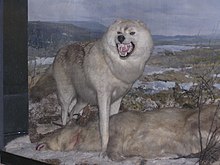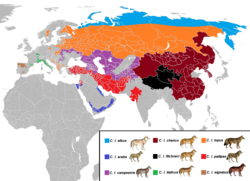bio.wikisort.org - Animalia
Il lupo grigio della tundra (Canis lupus albus), detto anche lupo grigio del Turuchan, è una sottospecie di lupo grigio indigeno delle zone di tundra e boscose dell'Eurasia, dalla Finlandia a Kamčatka.[2] Fu prima descritto nel 1792 da Robert Kerr, che lo descrisse come un abitante della zona presso lo Enisej, e che avesse una peliccia molto pregiata.[3]
| Lupo grigio della tundra | |
|---|---|
 | |
| Stato di conservazione | |
 Prossimo alla minaccia (nt)[1] (Finlandia) | |
| Classificazione scientifica | |
| Dominio | Eukaryota |
| Regno | Animalia |
| Phylum | Chordata |
| Classe | Mammalia |
| Ordine | Carnivora |
| Famiglia | Canidae |
| Genere | Canis |
| Specie | Canis lupus |
| Sottospecie | C. l. albus |
| Nomenclatura trinomiale | |
| Canis lupus albus Kerr, 1792 | |
| Sinonimi | |
|
dybowskii (Domaniewski, 1926), kamtschaticus (Dybowski, 1922), turuchanensis (Ognev, 1923) | |
| Areale | |
 | |
Descrizione
È una sottospecie grande, con i maschi adulti lunghi 118-137 cm e le femmine 112-136 cm. Sebbene spesso descritto come più grande del lupo grigio europeo, in realtà sono stati segnalati esemplari più grossi di quest'ultimo. Il peso medio è di 40-49 chili per i maschi e 36.6-41 chili per le femmine. Il peso più elevato rinvenuto fra 500 lupi abbattuti presso le penisole del Tajmyr e di Kanin nel 1951-1961 fu di un vecchio maschio ucciso a nord della Dudypta, pesante 52 chili. Il pelame è molto lungo, denso, e soffice, solitamente di colore grigio chiaro.[4]
Habitat
Si riposa generalmente nelle valli dei fiumi, nelle boscaglie e nelle radure.[5] Nell'inverno, si ciba quasi esclusivamente degli esemplari femmine o giovani delle renne selvatiche e addomesticate, sebbene le volpi artiche e altri animali vengono talvolta cacciate. I contenuti degli stomaci di 74 lupi catturati nel Circondario autonomo dei Nenec durante gli anni cinquanta contenevano 93.1% resti riconducibili alle renne. Nell'estate, si ciba di uccelli e piccoli roditori, insieme ai cuccioli neonati delle renne.[6]
Note
- The revival of wolves and other large predators and its impact on farmers and their livelihood in rural regions of Europe (PDF), su europarl.europa.eu.
- Mech, L. David (1981), The Wolf: The Ecology and Behaviour of an Endangered Species, University of Minnesota Press, p. 353, ISBN 0-8166-1026-6
- Kerr, R. (1792), The animal kingdom, or zoological system, of the celebrated Sir Charles Linnæus: containing a complete systematic description, arrangement, and nomenclature, of all the known species and varieties of the mammalia, or animals which give suck to their young, Printed for A. Strahan, and T. Cadell, London, and W. Creech, Edinburgh, p. 137
- Heptner, V. G. & Naumov, N., P. (1998) Mammals of the Soviet Union Vol.II Part 1a, SIRENIA AND CARNIVORA (Sea cows; Wolves and Bears), Science Publishers, Inc., USA, pp. 182-184, ISBN 1-886106-81-9
- Heptner, V. G. & Naumov, N., P. (1998) Mammals of the Soviet Union Vol.II Part 1a, SIRENIA AND CARNIVORA (Sea cows; Wolves and Bears), Science Publishers, Inc., USA, p. 210, ISBN 1-886106-81-9
- Heptner, V. G. & Naumov, N., P. (1998) Mammals of the Soviet Union Vol.II Part 1a, SIRENIA AND CARNIVORA (Sea cows; Wolves and Bears), Science Publishers, Inc., USA, p. 216, ISBN 1-886106-81-9
Altri progetti
 Wikimedia Commons contiene immagini o altri file su Canis lupus albus
Wikimedia Commons contiene immagini o altri file su Canis lupus albus Wikispecies contiene informazioni su Canis lupus albus
Wikispecies contiene informazioni su Canis lupus albus
На других языках
- [it] Canis lupus albus
[ru] Тундровый волк
Тундровый волк[1], или тундряно́й волк[2] (лат. Canis lupus albus), — подвид обыкновенного волка (Canis lupus), один из нескольких подвидов, обитающих в России. Ареал тундрового волка занимает зону тундры и лесотундры европейской части и Сибири вплоть до арктического побережья, а также Камчатки. Вопреки распространённому мнению, тундровый волк не является самым крупным из подвидов волка, уступая по этому критерию полярному волку. Размещение оленей по тундре определяет размещение волков.Другой контент может иметь иную лицензию. Перед использованием материалов сайта WikiSort.org внимательно изучите правила лицензирования конкретных элементов наполнения сайта.
WikiSort.org - проект по пересортировке и дополнению контента Википедии
